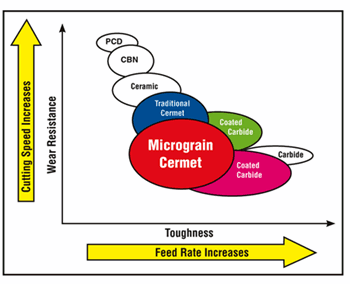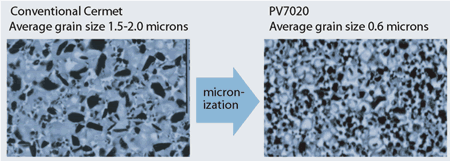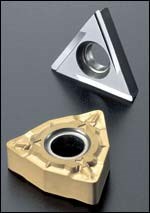Cermets Get Assertive
The toughness of this material has improved. Today, the applications for cermet inserts go well beyond finishing.
Share



Too many shops made up their minds about cermet inserts too long ago, says Scott Pettay, a cutting tool application engineer. Cermets today deserve a second look.
Take the perception that cermets can only handle light cuts. Historically, these inserts have machined at depths not much greater than 0.060 inch, but today, cermet inserts routinely cut steel at depths reaching 0.120 inch.
Then there is the perception that cermets are brittle. While cermets of the past were more uniformly vulnerable to impacts and thermal shocks, cermet inserts today are tougher—some of them offering flexural strength equal to that of P15 carbide.
Mr. Pettay works for Kyocera Ceratip Cutting Tools (Mountain Home, North Carolina), a company offering inserts made of various materials—carbide, ceramic, cermet, CBN and PCD. He says an important thing to understand about cermets, relative to these other materials, is the extent to which cermets’ performance envelope has changed. The development of micrograin cermets has enhanced the tool material’s toughness. On the continuum of toughness versus wear resistance, cermets used to occupy a smaller spot close to ceramics. (See the illustration below.) Now, cermets stretch farther on this graph, bridging the performance gap between ceramics and the toughest carbides.
What Is A Cermet?
The word cermet is a contraction of “ceramic” and “metal.” A cermet consists of a ceramic material (such as titanium carbide or titanium carbonitride) cemented with a metal binder. The ceramic provides the wear resistance, and the metal provides the toughness.
The combination is more chemically inert than tungsten carbide, Mr. Pettay says. The inertness means that edge buildup and crater wear are less likely. The result is not just improved tool life, but also an improved machined finish. One of the key benefits of cutting with a cermet edge is the ability to achieve a finish that may eliminate the need for polishing or grinding.
Cermets also feature higher hot hardness than carbide, meaning they maintain more wear resistance at high temperatures. As a result, cutting speeds can often be increased with these tools without compromising tool life.
Combining the wear resistance with today’s enhanced toughness makes the case for cermets stronger. Mr. Pettay says certain misconceptions about cermets are even less accurate today, including the following:
- Not true: Cermets cannot handle interruptions. Micrograin cermets can handle interruptions. Traditional cermets have been used in milling for years.
- Not true: Cermets must run at high speeds. Cermets tend to excel at high speeds, but the material can also perform well at speeds below 500 sfm.
- Not true: Cermets are limited to finishing steel. In addition to finishing, cermets can also be trusted to take semi-roughing cuts in carbon steels, alloy steels and tool steels. Cermets can also machine other materials, including gray cast iron, nodular or ductile iron, powder metals, non-ferrous alloys and even non-metals.
Certain materials do present problems, however. The source of these problems often relates to nickel.
Cermet Limitations
Nickel is a common binder material for cermets. This creates the potential for a chemical reaction if the workpiece has high nickel content, too. (That is, the cermets' inertness doesn't apply if nickel is involved.) High-temperature alloys and some stainless steels are among the nickel-containing materials that can cause problems when using uncoated cermet tooling.
Coated cermets are a different matter, however. These tools can actually excel in the machining of stainless steels. For safety, when machining nickel-containing materials, coated cermets are recommended.
Cast aluminum is also a problematic metal. The problem here is mechanical rather than chemical, and the culprit is silicon. Cermets generally do perform well when machining aluminum, but the high silicon content of cast aluminum has an abrasive effect that can compromise the insert’s ability to produce a smooth finish.
Other limitations of cutting with cermet inserts relate to strength. Cermets today are tougher than they once were, but their toughness still does not match that of the toughest carbides. Cermets are not appropriate for roughing. Also, because bending strength is low, cermets require lower feed rates.
Thermal shock presents an additional potential for danger. Coolant should be used only in continuous cutting applications where the coolant can remain on the cermet tool, such as finish turning and threading. Coolant should not be used for milling with cermets. Even in continuous cutting applications, says Mr. Pettay, coolant should be used only for cuts that do not exceed 0.010 ipr feed rate or 0.080 inch depth of cut.
Applications
Cermets are excellent at finishing. Beyond that, what other applications should prospective users consider?
Mr. Pettay points to four:
- Grooving. The combination of wear resistance, speed and increased toughness can make cermets outstanding in grooving applications. (In grooving, he says, coolant is recommended.)
- Near-net-shape parts. Another advantage of cermets’ stability is tight dimensional control. Light-depth-of-cut applications with close tolerance requirements, such as near-net-shape parts, are well suited for cermets.
- Parts in need of speed. If the feed rate is already limited by finish requirements and the depth of cut is already limited by the part’s dimensions, then speed is the only avenue left for increasing productivity. Cermets can provide this extra speed.
- Swiss-type machining. On a Swiss-type turning machine, feed rates are generally light and spindle speeds are often high—an advantageous combination for cermets. Cermet inserts can excel at holding the precise tolerances and finishes that often characterize the work on these machines.
To this list, Mr. Pettay adds a fifth application that may become more prominent over time: dry machining. Cermets’ limited ability to withstand coolant is a disadvantage only where coolant is used. As coolant disposal costs continue to rise, dry machining may represent a growing share of metalworking processes, potentially providing further reason why cermets deserve a second look.
Related Content
Inside the Process of Cutting Tool Recycling
Global Tungsten & Powders, part of the Ceratizit Group, sheds light on the processing steps that convert a shop’s used inserts into new tools and other applications.
Read MoreUnderstanding Process Damping in Milling Operations
Despite the advances in modeling machining operations over the past decades, process damping remains a topic of interest, including new tool designs that increase the effect.
Read MoreThe Future of High Feed Milling in Modern Manufacturing
Achieve higher metal removal rates and enhanced predictability with ISCAR’s advanced high-feed milling tools — optimized for today’s competitive global market.
Read MoreRead Next
OEM Tour Video: Lean Manufacturing for Measurement and Metrology
How can a facility that requires manual work for some long-standing parts be made more efficient? Join us as we look inside The L. S. Starrett Company’s headquarters in Athol, Massachusetts, and see how this long-established OEM is updating its processes.
Read More




























